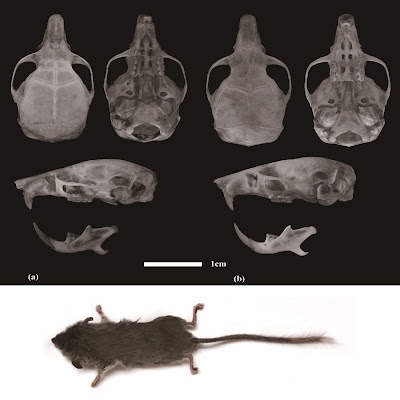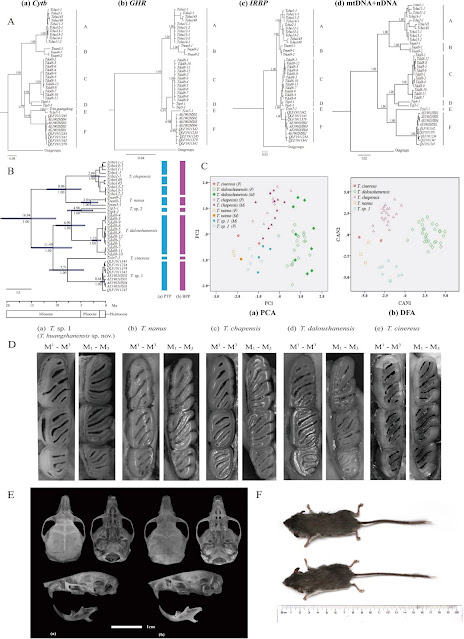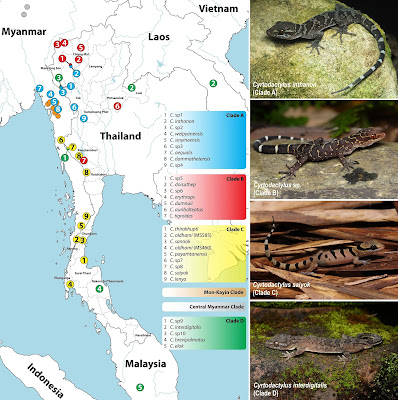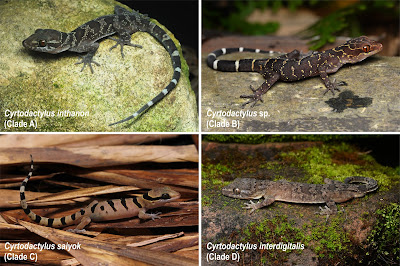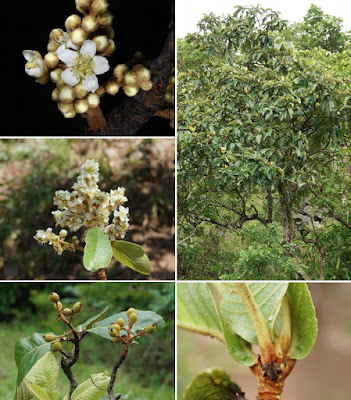[Most Recent Entries] [Calendar View]
Wednesday, February 3rd, 2021
| Time | Event | ||||
| 2:01a | [Mammalogy • 2021] Typhlomys huangshanensis • Molecular and Morphological Evidence for A New Species of the Genus Typhlomys (Rodentia: Platacanthomyidae) from China
Abstract In this study, we reassessed the taxonomic position of Typhlomys (Rodentia: Platacanthomyidae) from Huangshan, Anhui, China, based on morphological and molecular evidence. Results suggested that Typhlomys is comprised of up to six species, including four currently recognized species (Typhlomys cinereus, T. chapensis, T. daloushanensis, and T. nanus), one unconfirmed candidate species, and one new species (Typhlomys huangshanensis sp. nov.). Morphological analyses further supported the designation of the Huangshan specimens found at mid-elevations in the southern Huangshan Mountains (600 m to 1 200 m a.s.l.) as a new species. Keywords: Morphology, Phylogenetics, Species delimitation, Taxonomy Typhlomys huangshanensis Hu & Zhang, sp. nov. Type locality: Monkey Valley of Huangshan Mountains (N30.119, E118.306, 710 m a.s.l.), Tangkou Township, Huangshan City, Anhui Province, China. The specimen was deposited in the Biological Museum of Anhui University, Anhui, China. Diagnosis: The new species can be distinguished by a flattened braincase rather than the domed braincases of T. nanus and T. chapensis. It has a shorter skull than T. daloushanensis and a narrower interorbital breadth than T. chapensis. Its hind feet are covered with black hair, differing from the yellowish-white hair of T. daloushanensis. It has a longer upper molar than T. cinereus. In the new species, the anterofossettes on M1 are narrower than those in T. cinereus, and the anterofossettid of M2 is missing or inconspicuous. Ecology and habitat: The specimens were captured from a mixed evergreen and deciduous broad-leaved forest belt. Other sympatric small mammals included Apodemus agrarius, Apodemus draco, Callosciurus erythraeus, Micromys minutus, and Crocidura anhuiensis (Wang, 1990; Zhang et al., 2019). Distribution: Typhlomys huangshanensis sp. nov. is currently known from the Huangshan and Qingliangfeng mountains, Anhui Province, China. The known elevational range is 710–1 303 m a.s.l.. It might occur in other mountain areas in southern Anhui and western Zhejiang. Etymology: The specific name refers to its type locality, i.e., Huangshan Mountains, Anhui Province, China. We suggest the English common name as “Huangshan Blind Mouse” and the Chinese common name as “黄山猪尾鼠”. Ting-Li Hu, Feng Cheng, Zhen Xu, Zhong-Zheng Chen, Lei Yu, Qian Ban, Chun-Lin Li, Tao Pan and Bao-Wei Zhang. 2021. Molecular and Morphological Evidence for A New Species of the Genus Typhlomys (Rodentia: Platacanthomyidae). Zoological Research. 42(1); 100-107. DOI: 10.24272/j.issn.2095-8137.2020.132 | ||||
| 7:30a | [Herpetology • 2021] Phylogenetic Analyses of Distantly Related Clades of Bent-toed Geckos (Genus Cyrtodactylus) reveal An Unprecedented Amount of Cryptic Diversity in northern and western Thailand
Abstract Cyrtodactylus species are the most diverse of the geckos and are widely distributed in Southeast Asia, including Thailand. However, their patterns of distribution, especially in northern and western parts of Thailand, remain unknown because few Cyrtodactylus species in these regions have been described. Thus, a data set of mitochondrial NADH dehydrogenase 2 (ND2) gene and flanking tRNAs from Cyrtodactylus found in northern and western Thailand, including contiguous areas, was assembled to elucidate phylogenetic relationships and identify the distribution patterns of these geckos. The results showed four well-supported clades, a northwestern clade (A), a northern clade (B), a western clade (C), and a special clade characterized by specific morphological features (D). Clades A–C were grouped with strong support by the geography of their localities from northern Thailand (Mae Hong Son and Chiang Mai Provinces) along the Tenasserim mountain ranges to Phang-Nga Province, Thailand. Clade D is a distinct clade of Cyrtodactylus species characterized by a tuberculate and prehensile tail and distributed widely in mainland Southeast Asia. Overall, the results suggest a pattern of geographic separation and distribution of Cyrtodactylus in northern and western Thailand. Additionally, this study provides evidence of a hidden biodiversity of Cyrtodactylus in these regions. Conclusion: The phylogeny presented in this study illustrates the relationship and distribution of Cyrtodactylus species in northern and western Thailand. Four clades of Cyrtodactylus were recovered: a northwestern clade (clade A), a northern clade (clade B), a western clade (clade C), and a special clade (clade D). Clade A distributed from the Salween Basin in Myanmar to the Thanon Thong Chai mountain range in northern Thailand and was grouped with the “sinyineensis group”. Clade B was found to disperse in major mountain ranges of northern Thailand, including the Thanon Thong Chai, Daen Lao, and Khun Tan ranges. Clade C radiated along the Tenasserim Range from Kanchanaburi Province to Phang-Nga Province. Clade D was unique among the four clades in that Cyrtodactylus in this clade were grouped based on their tuberculate and prehensile tails, and were distributed widely in mainland Southeast Asia. The present phylogeny will be a useful guide for the identification or description of many unknown Cyrtodactylus species, especially from northern and western Thailand. The results also raise the possibility of analysis of other aspects of Cyrtodactylus species, such as their evolution, ecomorphology, and phylogenetic endemism. Finally, this study implies a hidden biodiversity of Cyrtodactylus in northern and western Thailand. Siriwadee Chomdej, Waranee Pradit, Chatmongkon Suwannapoom, Parinya Pawangkhanant, Korakot Nganvongpanit, Nikolay A. Poyarkov, Jing Che, Yangchun Gao and Shiping Gong. 2021. Phylogenetic Analyses of Distantly Related Clades of Bent-toed Geckos (Genus Cyrtodactylus) reveal An Unprecedented Amount of Cryptic Diversity in northern and western Thailand. Scientific Reports. 11: 2328. DOI: 10.1038/s41598-020-70640-8 | ||||
| 9:19a | [Botany • 2021] Eriobotrya shanense (Rosaceae) • A New Broad-leaved Species of Loquat from eastern Myanmar and Its Phylogenetic Affinity in the Genus Eriobotrya
Abstract Eriobotrya shanense, a new species from the karst region of Shan State, eastern Myanmar, is described and illustrated. This evergreen tree is similar to the autumn and winter-flowering, large-leaved species E. malipoensis and E. japonica by having tomentose hairs on the abaxial leaf surface, but can be distinguished by its obovate, widely obelliptic or oval blade shape, leaf length-width ratio of 2:1 (vs. 3:1), and rounded or obtuse apex (vs. acute). The species also resembles less-known, undercollected Myanmar broad-leaved species E. wardii and E. platyphylla in leaf shape and length-width ratio, but can be easily differentiated by the presence of tomentose hairs on the leaves, and inflorescence. Phylogenetic analysis based on nrDNA ITS region supported its close affinity with E. malipoensis and E. japonica. Molecular data also generally grouped the 17 congeneric taxa accessions in congruence to their leaf morphology, with the entire Eriobotrya clade strongly supported to be monophyletic and separate from Rhaphiolepis. Keywords: ITS, limestone karst, Panlaung Pyadalin Cave Wildlife Sanctuary, phylogeny, Shan State
Eriobotrya shanense D.H. Kang, H.G. Ong & Y.D. Kim, sp. nov. Type:— MYANMAR. Southern Shan State, Ywangan Township, N21° 14’ ...” E96° 25’ ...”, elev. 1,422 m, 01 Jan. 2017, Kim et al. MM-6026 (holotype HHU barcode 880000016009; isotypes HHU barcode 880000016016, KB barcode 880000016023, RAF barcode 880000016030). Diagnosis:— Leaf morphology of Eriobotrya shanense is similar to that of E. malipoensis and E. japonica by having tomentose hairs on the abaxial surface of its blade but can be differentiated by its obovate, widely obelliptic or oval blade shape, its length-width ratio of 2:1 (vs. 3:1), and rounded or obtuse apex (vs. acute). The species also resembles less-known, undercollected Myanmar broad-leaved species E. wardii and E. platyphylla in leaf shape and length-width ratio, but can be easily differentiated by the presence of tomentose hairs on the leaves and inflorescence. See Table 1 for a detailed comparison. Etymology:— Eriobotrya shanense is named after its type locality, Shan State in eastern Myanmar. Distribution and habitat:— Eriobotrya shanense is known to be narrowly distributed in its type locality, Ywangan Township in southern Shan State. So far, two populations have been found, one consisting of not less than 10 fullgrown trees, and the other of ca. 20 mature and juvenile individuals. The tree grows on slopes of irregularly rocky limestone karst hills, along with Firmiana kerri (Craib) Kostermans (1961: 389), Sterculia villosa Roxburgh (1832: 153, 154), Wightia speciosissima (D. Don) Merrill (1938: 67), Bauhinia variegata Linnaeus (1753: 375), Ceratostigma asperrimum Stapf ex Prain (1906: 6, 7), and Trichodesma calycosum Collett & Hemsley (1890: 92, 93). Dae-Hyun Kang, Homervergel G. Ong, Jung-Hoon Lee, Eui-Kwon Jung, Naing-Oo Kyaw, Qiang Fan and Young-Dong Kim. 2021. A New Broad-leaved Species of Loquat from eastern Myanmar and Its Phylogenetic Affinity in the Genus Eriobotrya (Rosaceae). Phytotaxa. 482(3); 279–290. DOI: 10.11646/phytotaxa.482.3.6 |
| << Previous Day |
2021/02/03 [Calendar] |
Next Day >> |
